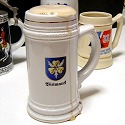
Minutes of the Visit of the Commander in Chief, Navy, at Headquarters Wolfsschanze on 1 to 3 January 1944.
The Commander in Chief, Navy, spent 1 to 3 January 1944 at Führer Headquarters.
He had many discussions on the current problems of the war with some of the leading personages, as well as with the Führer himself in private.
He reported to the Führer on the following matters in particular:
1. The course and the results of the engagement of the SCHARNHORST in the Arctic Ocean thus far, explained with the aid of a battle sketch.
Just as General Jodl, Chief of the OKW, Operations Staff, had done on a previous occasion, the Führer fully agreed with the idea that the Navy should make every possible use of its forces.
However, the thing that grieves him, aside from the unsatisfactory outcome, is the unanswered question, of how the task force commander could have made the grave error at 1223 of assuming that he was confronted by heavy ships, when only enemy cruisers were involved.
Our battleship, in fact, ran away from the cruisers, although it was superior to them both in fighting power and armor.
The Führer always suspects that such happenings occur because too much thought is given to the safety of the ships as in the case of GRAF SPEE.
The Commander in Chief, Navy, explained to the Führer that the engagement had proven that surface ships also are no longer able to fight without effective radar equipment.
We cannot expect our ships to be very successful in preventing enemy landing attempts, since the enemy has the equipment and is in a position to eliminate our ships beforehand, or to fight them during the approach.
Therefore much better results might be achieved by using the fleet for operations against convoys in the North and not as a defense against enemy landings.
Moreover, for reasons of strategy it is important to maintain our strength in the North, because this influences British invasion plans and also has some effect on the situation in the Pacific.
Therefore the Commander in Chief, Navy, gave orders to look into the possibility of transferring the heavy cruiser PRINZ EUGEN to the task force in northern Norway.
2. The problem of the Baltic Sea is likewise to be viewed in the light of the new submarine weapon, because the Baltic Sea is the only training area for the new offensive U-boats.
The Führer was fully aware of the problem.
He said that the situation in the South compelled him, nevertheless, to withdraw troops from the North, and that he was trying to replace them with Latvian and Estonian divisions.
Fortunately it so happens at the moment that the Russians are not very strong in the North.
Everything depends on checking the Russian offensive on the southern part of the eastern front and on holding the Crimea.
If the front can be stabilized in the South, forces would become available also for the North.
The Führer therefore remains firm in his determination not to yield an inch if he can help it.
Nevertheless it should be kept in mind that our forces in the North are so weak that we have to retreat if the Russians attack.
During this visit of the Commander in Chief, Navy, Minister Speer reported to the Führer on the new submarine construction program, i.e. the progress made so far in the prefabrication of Electro-Submarines.
Finally, the Commander in Chief, Navy, took this opportunity to have a far-reaching discussion between Minister Speer and himself on the one hand and the Reichsmarshall on the other, for the purpose of bringing about strict centralization of all German facilities and resources in the field of high frequency technique.
This discussion was to prepare the way for a later decision to this effect by the Führer.
For the same purpose, a demonstration of electrical equipment had been held earlier before the Führer for an hour, with a lecture by Dr. Lüschen, Chairman of the Central Committee for Electrical Engineering in the Ministry of Armaments and War Industry.
A report made by Professor Küpfmüller to the Führer and arranged by the Commander in Chief, Navy, and Minister Speer also was in the same vein.
It dealt with the problems of location in naval warfare.
To bring about this centralization, the Führer is planning to give Dr. Lüschen the necessary full powers over all developments in the field of electrical engineering, in addition to his other duties.
Furthermore, this authority is meant to give the "Deputy for Electrical Engineering“ as far-reaching an influence on research as possible.
During the discussion with the Reichsmarshall, serious differences of opinion occurred at first.
These were cleared away mainly because Minister Speer came out in support of the needed centralization and the measures suitable for bringing it about.
The Commander in Chief, Navy, and the Commander in Chief, Luftwaffe, reached complete agreement.
When the Führer inquired, they informed him accordingly.
Minister Speer and Dr. Lüschen subsequently proceeded to draft the text of the authorization called for by the decision reached, and to work out matters of organization detail.
countersigned: Korvettenkapitän Pfeiffer
|
 BOOK: The Battleship Bismarck. The Complete History of the Ship.
 Naval & military gifts
|
